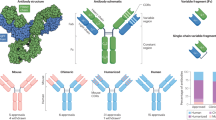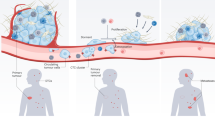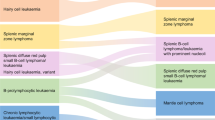Abstract
Platelets are thought to be involved in two important steps in the dissemination of cancer: (1) in their interaction with cells released from the primary tumour to form a mixed platelet–tumour cell embolus and (2) in the subsequent attachment or entrapment of this embolus at the vessel wall and the resulting extravasation of the tumour cell and growth of the secondary tumour1. We have recently used the Baumgartner perfusion chamber2 to evaluate the attachment phase of platelet–tumour cell interactions at subendothelial surfaces3. We have found that tumour cells which caused platelet aggregation (Hut 20 line, large cell carcinoma of the lung) were incorporated into mixed platelet–tumour cell thrombi on basement membrane or collagen microfibrils, while those tumour cells that did not cause platelet aggregation (A549 line, epithelial lung carcinoma), were not incorporated in this way. We have now found differences between different donors in the ability of their platelets to aggregate in response to various human tumour cell lines. These different individual susceptibilities seem to be largely independent of the cell line involved and may have implications in the evaluation of mechanisms of human neo-plastic disease.
This is a preview of subscription content, access via your institution
Access options
Subscribe to this journal
Receive 51 print issues and online access
$199.00 per year
only $3.90 per issue
Buy this article
- Purchase on Springer Link
- Instant access to full article PDF
Prices may be subject to local taxes which are calculated during checkout
Similar content being viewed by others
References
Sugarbaker, E. V. & Ketcham, A. S. Semin. Oncol. 4, 19–32 (1977).
Baumgartner, H. R. Microvasc. Res. 5, 167–179 (1973).
Marcum, J. M., McGill, M., Bastida, E., Ordinas, A. S. & Jamieson, G. A. J. Lab. clin. Med. 96, 1046–1053 (1980).
Gasic, G. J., Kock, P. A. G., Hsu, B., Gasic, T. B. & Niewiarowski, S. Z. Krebsforsch. 86, 263–277 (1976).
Holme, R., Oftebro, R. & Hovig, T. Thromb. Haemostasis 40, 89–102 (1978).
Pearlstein, E., Cooper, L. B. & Karpatkin, S. J. Lab. clin. Med. 93, 332–344 (1979).
Hara, Y., Steiner, S. & Baldini, M. G. Cancer Res. 40, 1212–1216 (1980).
Gastpar, H. Thromb. Diath. haemorrh. 42, 291–303 (1970).
Bastida, E., Ordinas, A. & Jamieson, G. A. Cancer Res. (submitted).
Author information
Authors and Affiliations
Rights and permissions
About this article
Cite this article
Bastida, E., Ordinas, A. & Jamieson, G. Idiosyncratic platelet responses to human tumour cells. Nature 291, 661–662 (1981). https://doi.org/10.1038/291661a0
Received:
Accepted:
Issue Date:
DOI: https://doi.org/10.1038/291661a0
This article is cited by
-
Boosting the antitumor effect of doxorubicin by combined correction of hemostasis
Bulletin of Experimental Biology and Medicine (1995)
-
The effect ofPaeonia rubra 801 on the occurrence of lung metastases in walker 256 tumor
Chinese Journal of Cancer Research (1993)
-
Disturbance of function of vascular and platelet components of the hemostasis system during tumor growth
Bulletin of Experimental Biology and Medicine (1989)
-
Inhibition of tumor cell-platelet interactions and tumor metastasis by the calcium channel blocker, nimodipine
Clinical & Experimental Metastasis (1984)
-
Inhibition of tumor cell metastasis by modulation of the vascular prostacyclin/thromboxane A2 system
Clinical & Experimental Metastasis (1983)
Comments
By submitting a comment you agree to abide by our Terms and Community Guidelines. If you find something abusive or that does not comply with our terms or guidelines please flag it as inappropriate.



